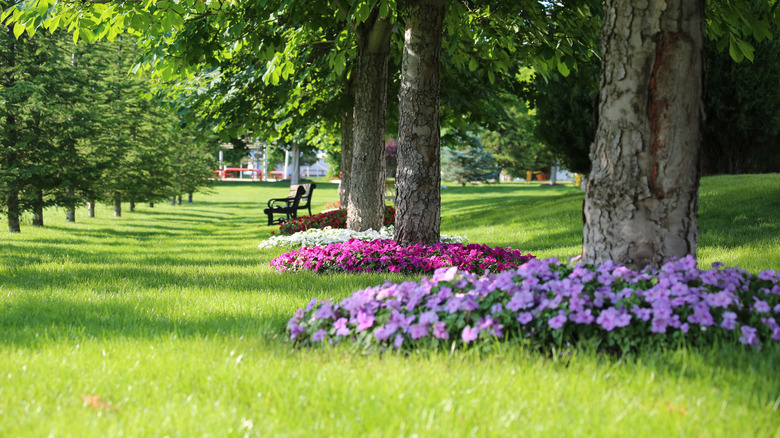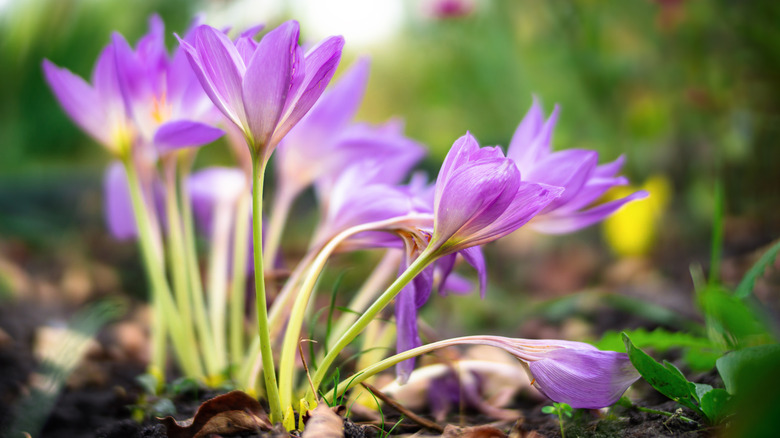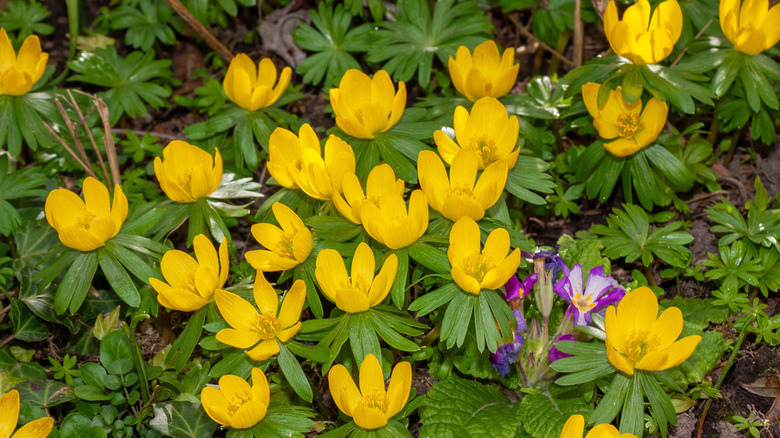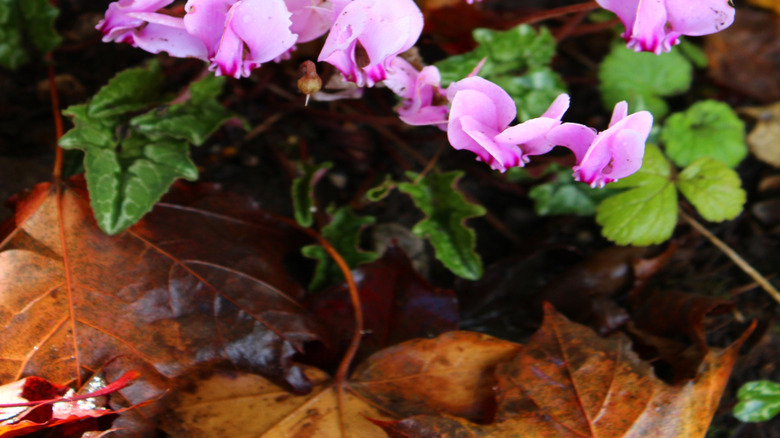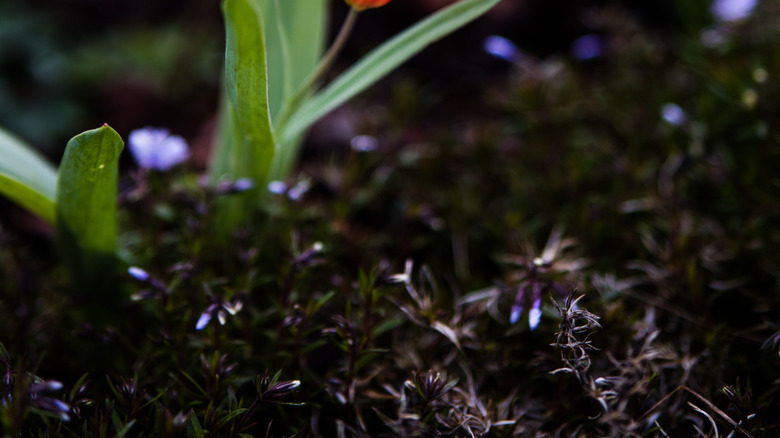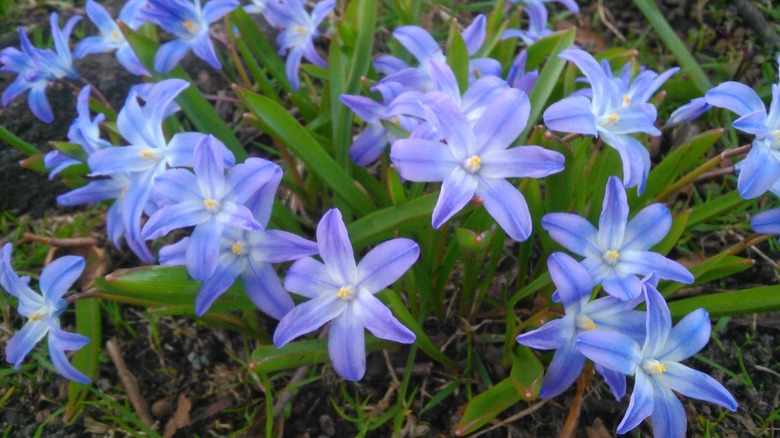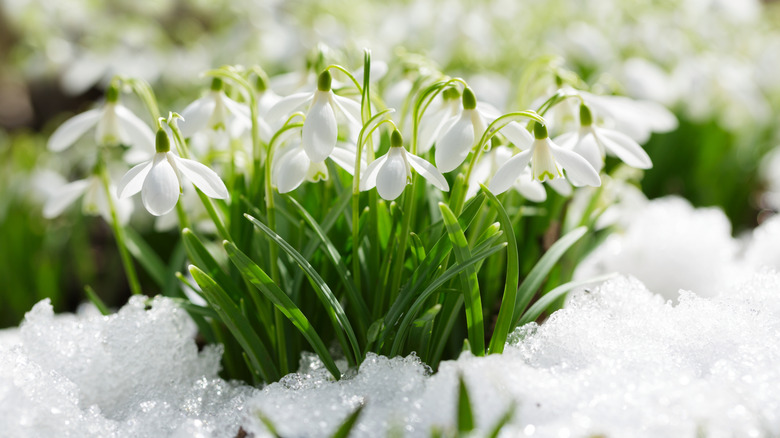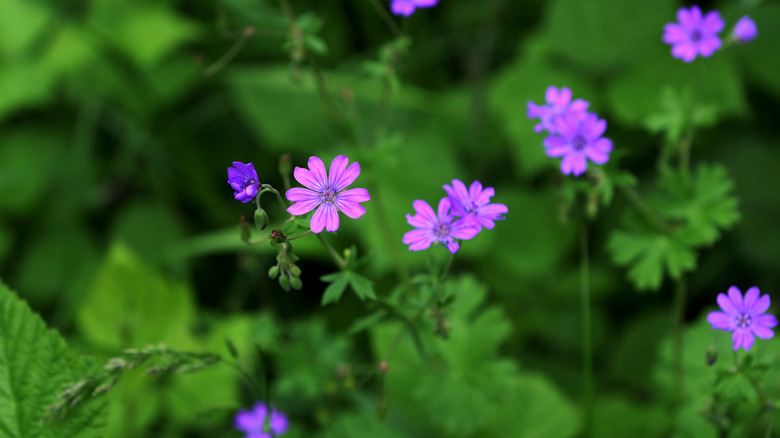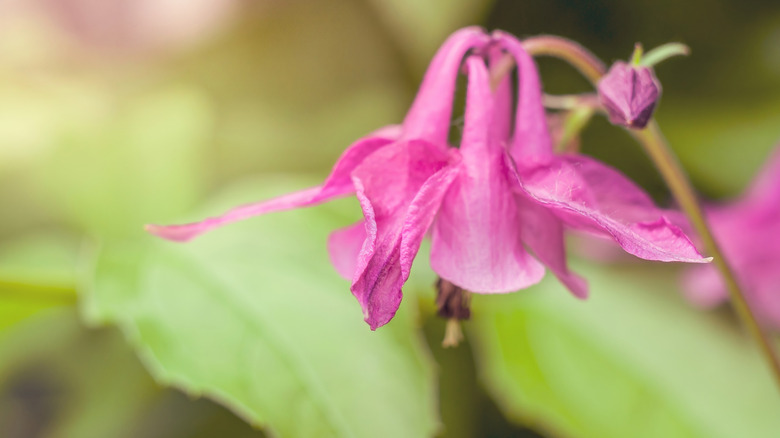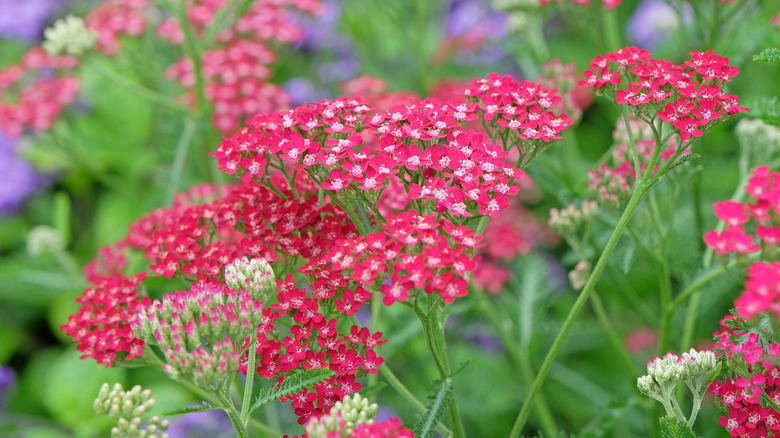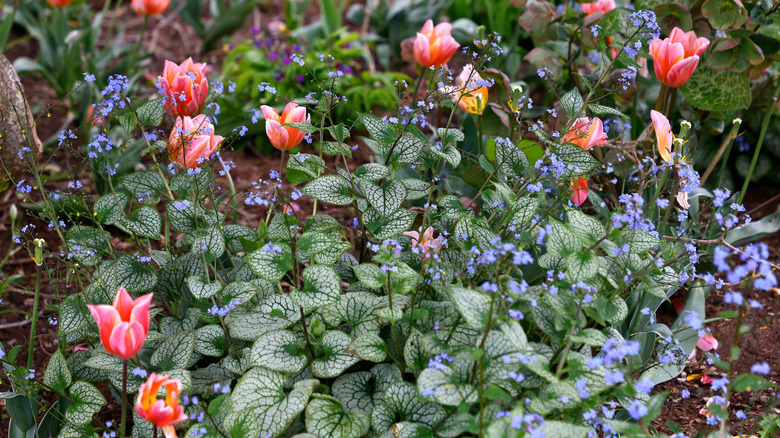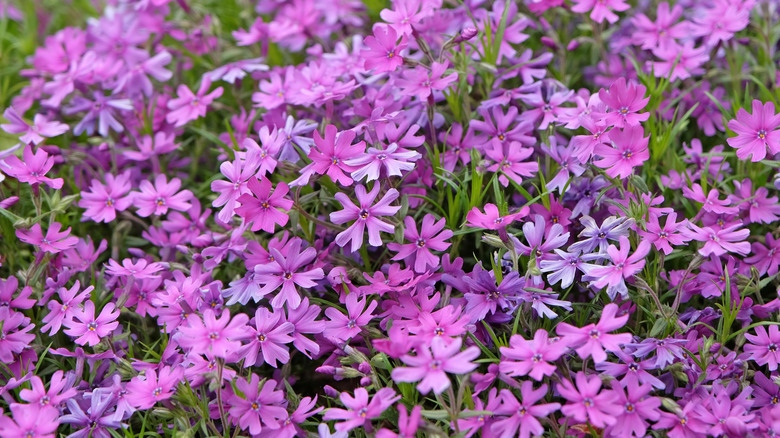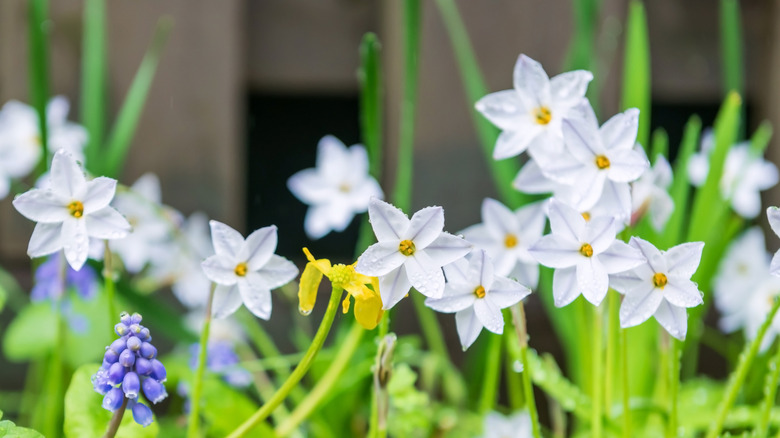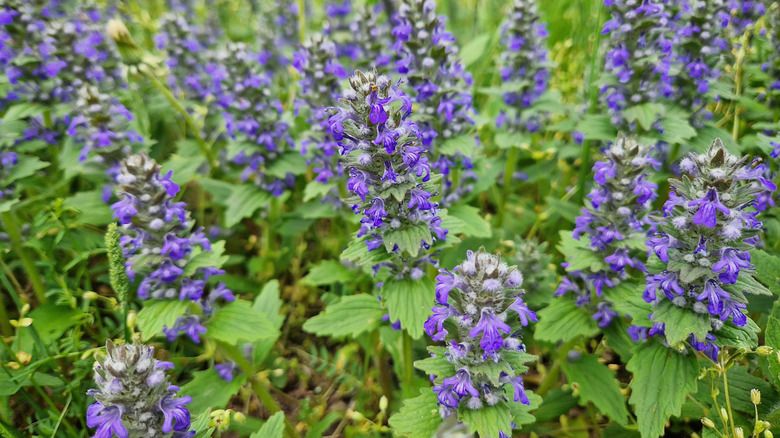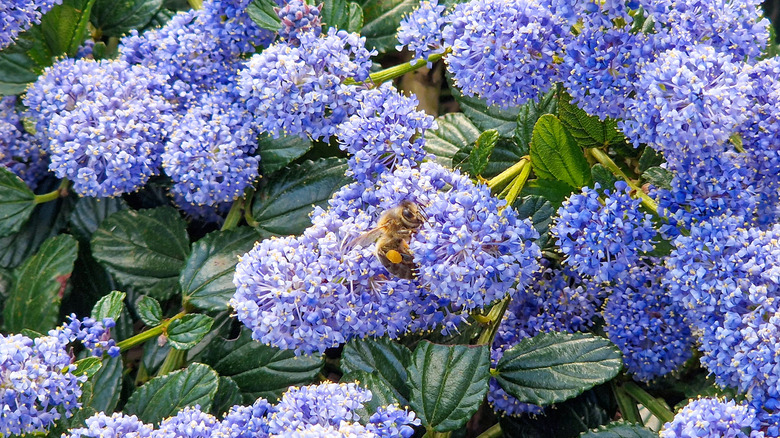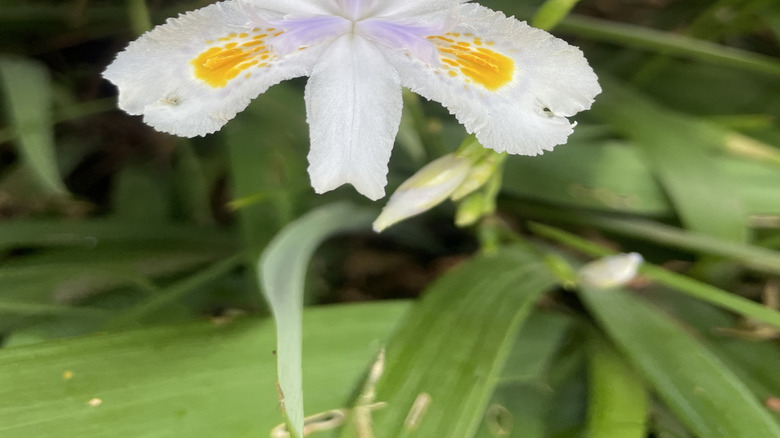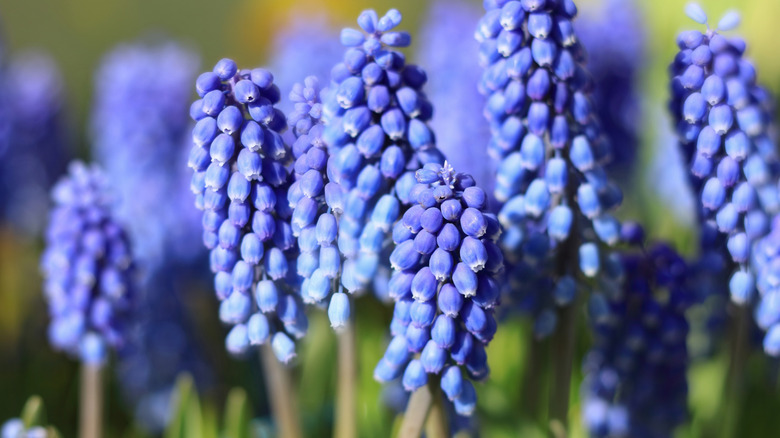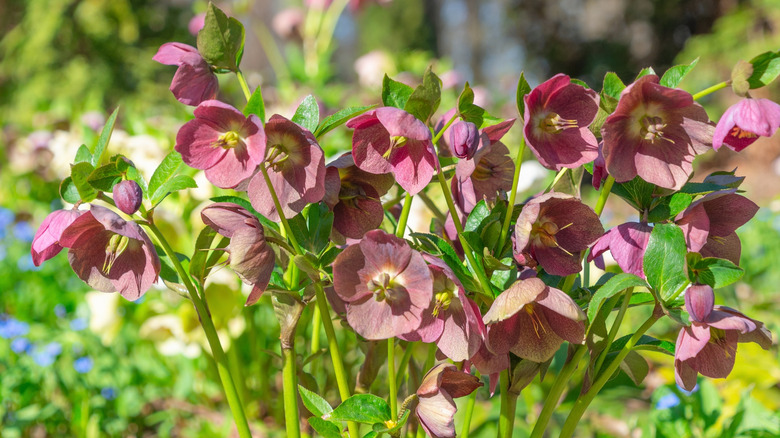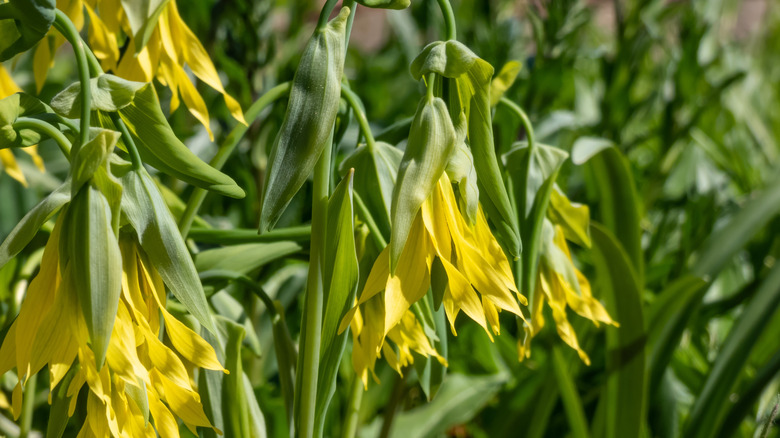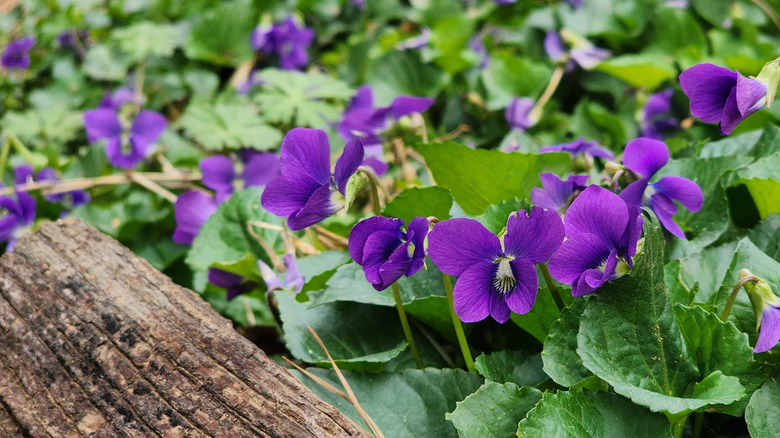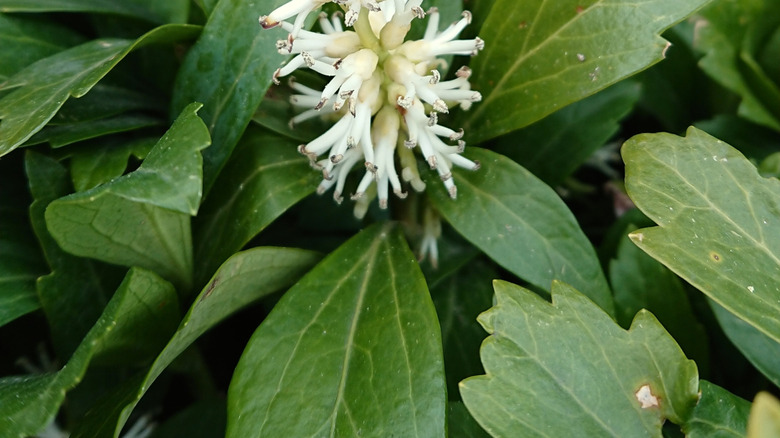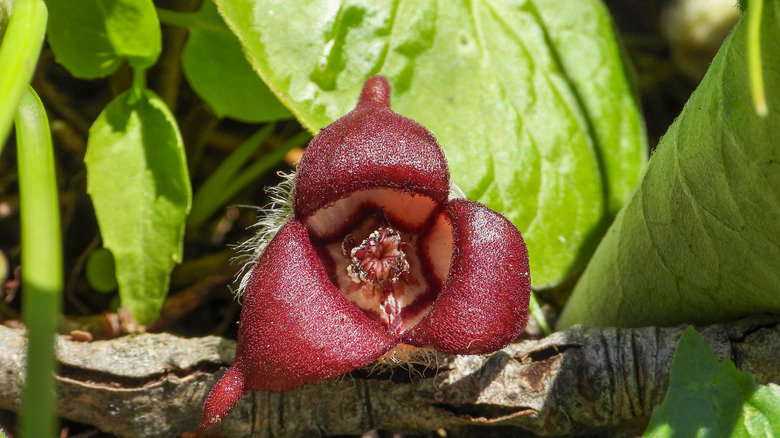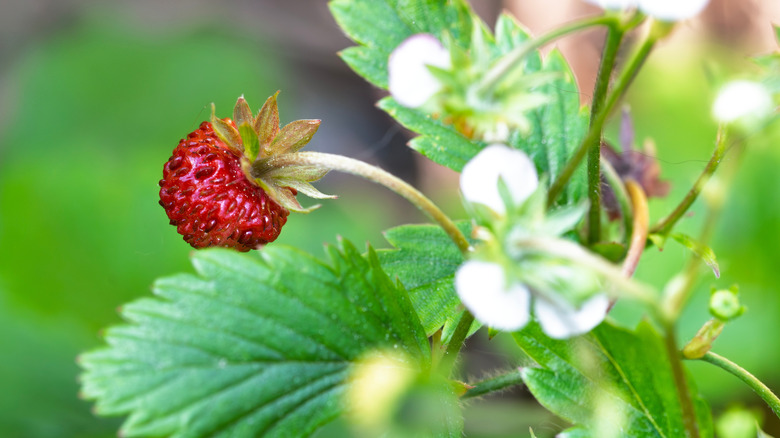22 Beautiful Flowers That Can Grow Under Trees With Even The Thickest Roots
Sunlight is the best disinfectant, they say, and you might occasionally hear that it's also the best medicine. It also turns out to be a vital source of, well, sunlight for plants that require lots of it to grow and, often, to produce the most dramatically colorful and stunning flowers. So, as much as we love the dappled shade beneath and betwixt the trees in our woodland gardens, sometimes the flowers that grow there aren't as showy as we might prefer.
There are, of course, some great options, but it's a tough business living underneath the canopy of trees. Their roots tend to hog the soil, and you can't just pile on new soil without threatening to suffocate the tree. They also prevent a lot of rainfall from reaching plants below them, and suck up much of the moisture that does find its way there. Soil moisture varies widely under tree canopies, but conditions are usually dry. Trees with deep roots (like hickory, loblolly pine, and oak) in well-drained soils tend to foster more moist soil. So, all things being equal, you're more likely to have luck with flowers that don't need a lot of water in addition to little sunlight. Additionally, shallow-rooted trees, like maples and spruce (both good options to plant during dormant season), require shallow-rooted understory plants.
With all this in mind, we've found 22 beautiful flowers that can grow under trees with even the thickest roots. Consider these choices for your garden, or use them as inspiration to track down even more.
Meadow Saffron
We'll start with bulbs and bulb-like flowers that do well under trees. In this category, meadow saffron (Colchicum autumnale) is a gorgeous, crocus-like bloom. Usually purple but sometimes white, it can come in a number of shapes, depending on the cultivar. "Nancy Lindsay" is a favorite, with petals a bit more pointed than some varieties but not as feathery as others. Note that this is an acutely toxic and medicinal plant, so keep children and pets clear of it. Meadow saffron is hardy in zones 4 to 9 and prefers moist soil.
Winter aconite
Another toxic plant worth considering is winter aconite (Eranthis hyemalis), one of the most interesting-looking flowers on our list. This member of the buttercup family has the cup-shaped flowers you'd expect, set above rays of lobed green leaves that look like an additional layer of petals. Winter aconite does well when it can get early-season sun while blooming, then relax in the shade of a tree canopy that is leafing out. It does need a little soil depth — 2 inches or so — and partial sun, and will do well in zones 4 to 9.
Ivy-Leaved Cyclamen
Ivy-leaved cyclamen (Cyclamen hederfolium) is another interesting choice — a delicate understory plant that is nonetheless quite tough. Its somewhat stately little blooms in magenta, pink, and white float atop an often-variegated raft of leaves that call to mind nothing so much as the foliage of water lilies. Like winter aconite, it needs a couple of inches of soil depth. Hardy cyclamen is hardy in zones 5 to 9, and should be planted about an inch deep.
Sprenger tulip
The Sprenger tulip (Tulipa sprengeri) is somewhat uncommon, and appears to be extinct in the wild. But it's worth the trouble to track down. It's also worth the wait for it to bloom; while this tulip blooms later than most, in late spring and early summer, once it does you'll be astounded at the regal apricot to red blooms held high on arrow-straight stalks. It's both hardy and drought-tolerant in zones 3 to 8. The only catch is that it needs to be planted 4 inches deep, so it's not good for growing under shallow-rooted trees.
Glory of the snow
Unlike the Sprenger tulip, glory of the snow (Scilla sect. Chionodoxa, formerly Chionodoxa luciliae) is a blue-flowering spring bulb. It lives up to its name by blooming in very early spring with star-shaped flowers ranging from light blue to pinks and white. Like the Sprenger tulip, it requires a bit of depth — around 3 inches. It's well-known for enjoying the shade of trees in zones 3 to 9, after intense flowering while late winter or early spring sunlight can still reach the plants most of the day.
Snowdrop
Snowdrop (Galanthus nivalis and others) is the superstar of shallow, shade-loving bulbs, and will give your garden a uniquely woodland feel. It is hardy in zones 3 to 8 and is good company for plants like winter aconite that also bloom in early spring. Plant them as shallow as 2 inches in fall and give them a little light, and from late winter to early spring you'll be rewarded with drooping blooms that are lovely at a distance and sublime up close.
Cranesbill
Cranesbill is a sterile hybrid geranium and looks the part, but with white or pink blooms that are sometimes extraordinarily pale, showing off pink stamens. It'll do well in low-water conditions, but needs a bit more in order to spread as much as you will probably want it to. Or you can propagate cranesbill by division between fall and early spring. The root crown should be ½-inch below the soil line. Cranesbill is hardy in zones 5 to 8.
Barrenwort
Barrenwort (Epimedium) is a drought-tolerant ground cover that blooms in the shade. But the delicate, pale yellow flowers of this herbaceous perennial are only half of its color story. Like other Epimediums, its foliage is often variegated. This particular one has a gradient that runs from dusty rose at the leaf edges to green veins. Barrenwort, unlike many plants that spread by rhizome, is a slow-grower. Plant it in zones 4 to 8 or 9, with its root crown just above the soil line. You may also want to pair it with these companion plants.
Yarrow
Common yarrow (Achillea millefolium) is probably a plant you associate more with open meadows and plenty of sunlight. However, aided by its shallow root system, it will grow well (if a bit leggy) in the dry shade of a tree. It's tall already, with fernlike stems, and its foliage might call to mind short-leafed evergreen trees, or perhaps ferns again. Colors vary wildly by cultivar, and nothing says you have to plant just one. However many you plant, do it in zones 3 to 9.
Siberian bugloss
Siberian bugloss (Brunnera macrophylla) is one of those plants whose name doesn't quite do its beauty justice. It's an herbaceous perennial, hardy to zones 3 to 8, with tiny blue blooms, and is sometimes known by the slightly less off-putting name false forget-me-not. Topping out at 1½ feet tall, it's a little on the moundy side for a ground cover. But some variegated varieties, like the patented Jack Frost, bring a tremendous amount of color to your shady spots, and it's totally worth it in an area where you won't be playing a lot of bocce.
Creeping phlox
Creeping phlox (Phlox subulata) is a ground cover that tops out at a height of 6 to 12 inches and can withstand light foot traffic. You'll often see it grown between pavers, presumably on the assumption that people will mostly step on the pavers and not the phlox. In any event, its spring blooms are nothing short of spectacular. Hardy in zones 3 to 8, it does need a lot of sun, but if your trees are situated to allow for 6 to 8 hours of direct light per day, this might be the ground cover for you.
Spring starflower
Spring starflower (Ipheion uniflorum 'Wisley Blue') looks like nothing so much as grass that has decided to explode in the prettiest white and blue flowers. It spreads well and is pretty hardy, but doesn't always handle heavy foot traffic well. It will do well under trees and shrubs, though, and since it handles light foot traffic reasonably well, it's a great candidate for the most stubborn root zones. Since Ipheion likes well-drained soil, which can be hard to come by in a network of shallow roots, spread some organic matter before planting.
Ajuga
Ajuga (a colorful ground cover plant that can help prevent weeds) is generally hardy in zones 3 to 10 and flowers in May and June. It thrives in sun or partial shade. Ajuga typically has somewhat shallow roots and spreads quickly. Ajuga reptans is considered invasive in West Virginia, Oregon, and Maryland, so it might be wise to consider a non-invasive and commonly cultivated variety like Ajuga genevensis (standing or blue bugle), which doesn't spready by runners and is easy to control. Also note that some of the 40+ varieties of Ajuga are happier being trod upon than others.
Ceanothus
Ceanothus, widely known as California or wild lilac, is a genus containing about 60 shrubs, often in the 6 to 8-inch range and known for their preference for dryish solis and lots of sun, but there are varieties that can handle the partial shade beneath a tree just fine. Your reward for sorting out which is best for your area: little explosions of fragrant, white to purple flowers in late spring to mid-summer. Some have deep taproots, so look for a cultivar with a shallow root system, like cup-leaved ceanothus (Ceanothus perplexans).
Bamboo iris
One of the species known as bamboo iris, Iris confusa is right at home in partial shade in zones 9 to 11, and isn't overly particular about water or soil conditions. It has a groundcover-like growth habit and its roots run 3 to 4 inches deep. In spring it grows 2 to 3 feet tall and blooms with a profusion of flowers on branching stems that can produce up to 75 flowers each. The blooms have a distinctly orchid-like appearance, and some are delicately scented.
Grape hyacinth
You might not know where Siberian bugloss gets its name, but you won't be confused about the origin of the "grape" in grape hyacinth (Muscari armeniacum) once you get a look at its blooms. Each stem produces a spire or cone-like bunch of 20 to 40 blue-purple flowers that look like nothing so much as a bunch of grapes. It's not actually a hyacinth, however... nor a grape, for that matter. Each bulb unleashes 1 to 3 stems. Plant grape hyacinth bulbs 3 to 4 inches deep and enjoy these partial-shade-loving wonders. Just note that some U.S. states consider grape hyacinth to be invasive, so it's best to double-check you're not in one of these areas before planting.
Lenten rose
Any excuse to plant Lenten rose (Helleborus x Orientalis or Helleborus x hybridus) is a good one. There's a lot of variety in the Lenten rose's foliage and blooms, but they are always amazing, with leathery leaves and early spring blooms in antique shades, many of which you've never seen on a flower before. Grow them in zones 5 to 9 and they don't require much in the way of maintenance, but you might need to add some organic matter to the soil occasionally.
Bellwort
Bellwort (Uvularia grandiflora) is a native with the much more fun common name of great merrybells. This member of the lily family grows from rhizomes and has relatively shallow roots. It produces clusters of long, yellow, downward-facing blooms in very early spring. When in bloom, they can look a bit droopy... but can't we all? They handle shade fine, but like moist and rich soil. They prefer partial sun, which is more than some understory plants — but partial sun is also partial shade.
Common blue violet
Viola sororia, the common blue violet, has a ton of other regional names because it is, well, common. But common isn't bad, and this wild violet is actually one of the best fast-growing purple plants for a beautiful shade garden. It can flourish underneath trees, even black walnuts, which can be a pain to plant below. Violets like dappled shade and moist soil, but they're pretty adaptable and after they're well-established they can deal with most conditions. They're hardy in zones 3 to 8. Viola is capable of putting down deep roots, but will also thrive where there's as little as 2½ inches.
Allegheny Spurge
The blooms of Pachysandra procumbens (Allegheny Spurge) are a bit more sedate than other options, with their muted whites to light reds. It's quite beautiful in that kind of Victorian dusty hue kind of way, though no one would accuse it of being showy. But the foliage is more than enough to make up for any shortcomings in the blooms. It's a sometimes mottled, slightly leathery groundcover that's evergreen in some parts of zones 7 and 8. It is endangered in several southeastern states, though it's relatively common in gardens.
Wild ginger
While we're on the topic of muted flowers, wild ginger (Asarum canadense) has blooms that are so low-key they can be easy to miss entirely, but once you see them up close, they're quite arresting, if a little otherworldly. Also, it's worth noting that the, well, ginger-flavored wild ginger is nonetheless likely to be toxic. Wild ginger is a lovely groundcover that grows in zones 4-8 and is perfectly happy in the shade.
Wild strawberry
When you talk about wild strawberry (Fragaria virginiana), you naturally talk about its fruits. But this is a very pretty native groundcover that blooms with lovely, delicate little white, yellow-centered flowers. The strawberries themselves are actually part of that flower, the receptacle, and the fruit are very sweet to aid in seed dispersal. This is a perennial in zones 4-9. Be careful to avoid the mock strawberry (Potentilla indiga), which looks similar but is invasive and produces tasteless fruit.
